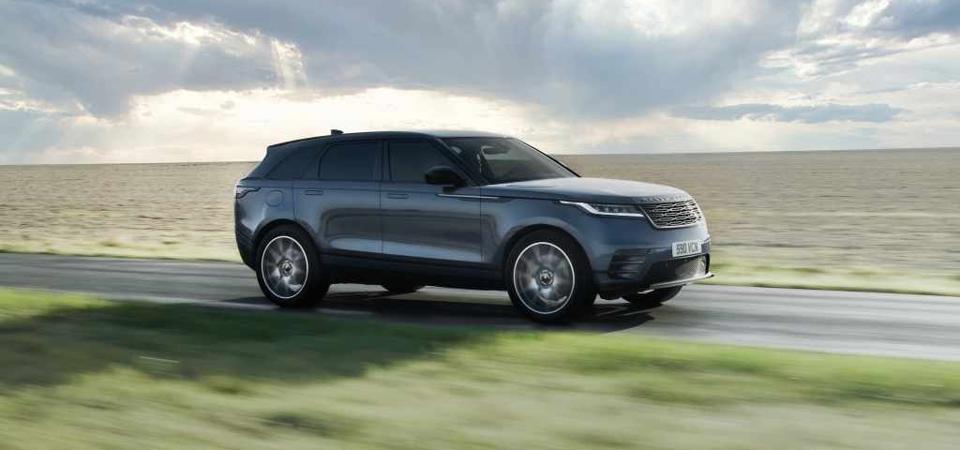Before babbling about Range Rover Velar life, here’s a fact regarding its name. Velar comes from the Latin word ‘velare’, which means to veil or cover. Land Rover used this name in the sixties to hide the identity of 26 concept vehicles before applying it to a production car in 2017—the Range Rover Velar.
There are many Range Rovers to choose from, but the Velar sits between the modest Evoque and the Sport, the one all the rappers buy.
Life With The Range Rover Velar
I get stoked whenever Land Rover sends a car to Scotland. It doesn’t happen often, odd considering Scotland has so many muddy fields just waiting to be destroyed, but a Varesine Blue Range Rover Velar D300 was soon sitting on my driveway. And, God, it looked good.
It might just be a five-door SUV, but look at its stance, its detailing and its lines. I could’ve sat in a garden chair and admired it for hours, but that would’ve likely concerned my neighbours, who already question why I have a different car each week.
Inside, it looked even better. My loaner had Shadow Grey Ash veneer and black leather seats. Everything was soft to touch except the scratchy instrument binnacle. It’s incredibly minimalistic, and that’s a catch-22.
You see, controlling in-car technology from an 11.4-inch touchscreen is a bit like removing your home’s light switches and linking every room to a separate smartphone app. A daft decision that’s all a bit much; I don’t want to faff around with my phone to turn on the kitchen light. The same applies here.
There are few physical buttons in the Velar’s cabin, and the touchscreen, although fast and crisp, can be quite confusing with all its submenus. Fortunately, Land Rover’s Pivi Pro infotainment system is good and changing the cabin temperature via the voice assistant is easy. But I miss the pre-2023 Velar’s rotary dials. If you veer off the road into a field trying to enable the window demist, you’ll be fine; the Velar boasts a five-star EuroNCAP rating and is more than capable off-road.
Land Rover fitted this press car with optional 21-inch alloys, wrapped in Michelin Latitude rubber, which meant a smooth ride, despite the alloy size. Engaging Eco hardened the ride slightly, and I found it to have little impact on efficiency.
Other modes included Snow, Gravel, Grass, Sand and Mud Ruts, and these combined with the Velar’s trick air suspension, mean you’ll struggle to get stuck in the rough. The Dynamic SE gets an additional Dynamic setting. This makes cornering less wafty by adding heavier steering, tightening the suspension and increasing gearbox and throttle response. I used it once before switching back to Comfort.
Dynamic releases all 700Nm and 296 bhp, meaning 0-to-62mph takes 6.2 seconds, while 30-70mph arrives in 5.2 seconds. It’s no vomit-comet, but it’s the perfect engine for this car. Anything more powerful is overkill, really.
My week consists of going to and from dog parks via motorways and B-roads after working hours. Therefore, I was delighted when Land Rover agreed that both furry babies, Freya the Siberian Husky and Chloe the Shepkita, could ride in the boot. The press team even offered to send up a Land Rover dog kit next time, which includes a dog ramp, a dog washer, rubber mats and a water bowl.
Both dogs are fairly large, but both struggled to climb into the Velar’s boot, even with the clever Access suspension lowering mode enabled. So this meant lifting them in. However, there’s ample space back there, and there’s a net for holding water bowls and treats. Lifting the boot floor reveals a deep cubby.
The car needed a clean inside and out afterwards, and this is where I discovered a slight issue. The Velar’s seats wipe easily, as do the front and rear carpets, but hoovering the boot floor was easier said than done, despite the dogs lying on a large blanket.
Because of the material, like many other cars, the small white hairs intertwine among the fabric, meaning I spent around 30 minutes pulling each tiny husky hair out. This might not bother you, but I didn’t want the next journalist to think a yeti had been onboard. So, if you run a dog-moving business or own pooches, it’s worth opting for Land Rover’s rubber mats.
After a week, I handed over the keys with some closing thoughts. The efficiency screen showed a 37.7 mpg average, with most runs returning around 35 mpg. Impressive figures, considering the Velar D300 weighs 2,710kg (gross).
With options, the car cost a mighty £72,665 ($97,411). That’s a lot, and I didn’t even use all its configured options like the £440 Wi-Fi plan, £105 Terrain Response 2 system, heated rear seats or configurable steering or chassis dynamics settings.
Out of the box, the Range Rover Velar D300 is well-equipped, and if you don’t often climb rocks or traverse the Sahara, you won’t need any fancy optional terrain tech. Therefore, a new Velar could be sat on your driveway for £66,905. Buy one and you’ll never tire of turning round for one last look before walking through the front door.

